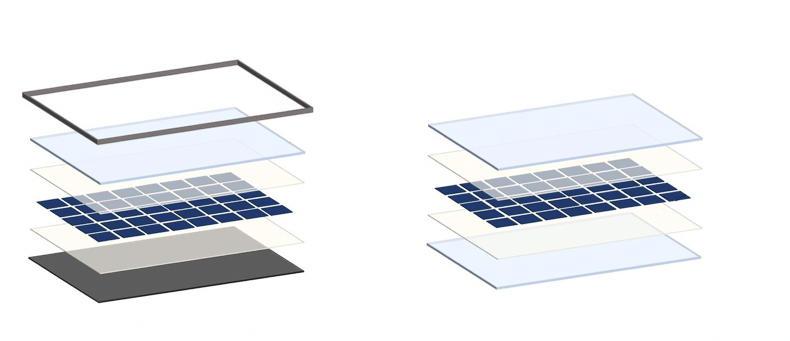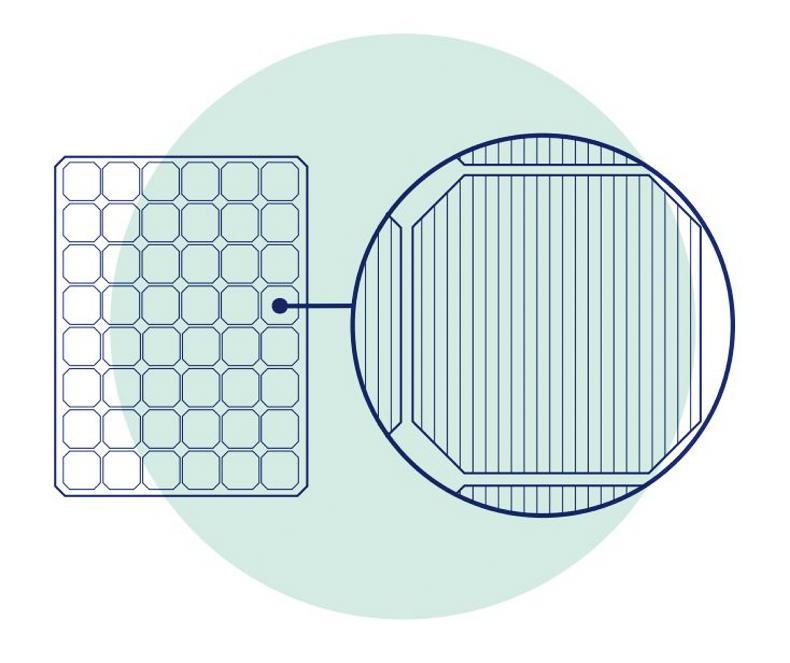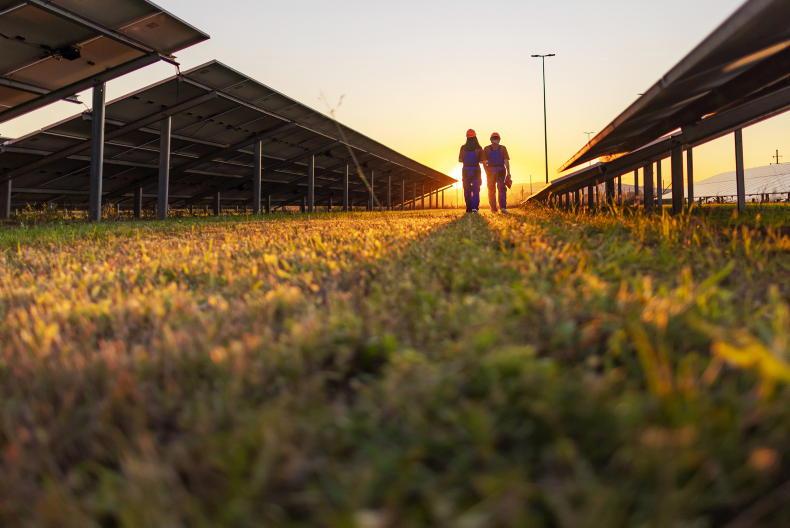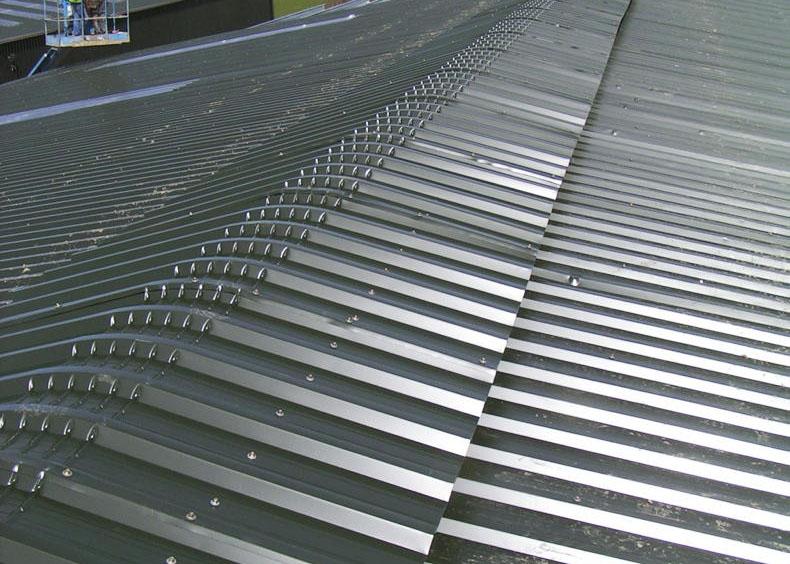With grant aid set to increase to 60% for solar photovoltaic (PV) panels under TAMS, next year is set to be a big year for the technology on farms. Once a solar PV system is installed on a farm, it will be expected to last 25 to 30 years. So, selecting the right panel for your farm is important.
There are now many suppliers of solar PV systems in Ireland, each supplying different kinds of panels and hardware.
This article will run through some of the main differences between the types of panels on the market. However, as with all farm purchases, thoroughly researching the product is vital before making any investment.
A solar PV system generates electricity from sunlight. The system is made up of four main components, PV panels, an invertor, mounting brackets and grid protection.
Solar panels are made up of a series of PV cells. Panels are generally differentiated based on the semiconductor materials used to make PV cells, ie the materials that enable them to absorb light. When researching panels, you will find reference to three main types. These are monocrystalline, polycrystalline and thin film solar cells. While there are differences in all three, the majority of modern panels used in Ireland are monocrystalline.
Monocrystalline panels are more expensive to manufacture but are considerably more efficient, so this is the only type of panel you should look for.
Glass-glass v glass-foil
There are two main types of monocrystalline panels on the market in Ireland. These are glass-foil and glass-glass.
Most standard solar PV panels are glass-foil. This means that the PV cells are placed between a plane of glass (on top) and foil laminate (underneath). These panels are cheaper, so have a lower initial investment for the farmer.

Glass-foil v glass-glass. Source: Fraunhofer ISE
Depending on the supplier, the panels typically come with a 25-year performance guarantee.
The amount of sunlight which panels can convert to electricity generally reduces over the lifetime of the system.
Generation from glass-foil panels typically reduces quicker than glass-glass panels, anywhere between 0.55% and 0.7% per year. That means that at the end of the panel’s lifespan, they could be operating at around 84% efficiency. Many of these types of panels are manufactured outside of the EU.
Glass-glass panels are regarded as the premium panels on the market.
Here, the PV cells are placed between two planes of glass. The cells are typically better protected from the environment so have a longer life expectancy and, depending on the supplier, come with a 30-year performance guarantee.

Monocrystalline PV modules. \ SEAI
These panels have a lower annual degradation rate of around 0.34% per year. That means these panels are guaranteed to perform at around 87% after 30 years.
Most of these panels installed in Ireland have been manufactured in the EU.
Let’s be honest, like any other piece of hardware installed on farms, there will be problems. These problems won’t be experienced by all, but certainly by some. That’s when the panel’s warranty becomes important.
Solar PV panels generally come with a performance guarantee and product warranty.
Depending on the supplier and panel choice, panel warranties can range from 10 to 30 years.
However, reading the fine print in any warranty is essential.
Some panels come with multiple warranty limitations and exclusions.
In some cases, warranties become null and void if installed in a harsh environment such as near the sea (exposed to salt mist) or on a farm (damaged by ammonia). This could be a particular problem for farmers who typically install panels on shed rooftops which could be exposed to gasses and harsh conditions.
Dispute
Furthermore, if you have a dispute with a supplier over a product warranty, it may be easier to resolve with a European panel manufacturer than one outside of the EU.
The same principles apply with invertors which typically come with a five-to-seven-year product warranty.
On average, there is a 15% to 20% cost difference between glass-foil and glass-glass panels.
If we compare the cost of each panel, including inverters on a per kilowatt hour basis for a small system, it would cost around €1,250/kWh for glass-foil panels versus €1,450/kWh for glass-glass panels.
While the price per kilowatt hour for larger systems would decrease, the difference between the panels would be the same.
When you’re weighing up the investment, be sure to take into account the panel’s lifespan, expected performance and warranty, and not just look at it on a cost per kilowatt basis.
Remember, from 2023, farmers will be able to avail of a 60% TAMS grant on solar PV systems on their farm.
The two main types of panels on the market are glass-glass and glass-foil panels. Look out for the panel’s stated efficiency, degradation rate and performance guarantee. Dust, dirt and gasses around farms mean that farmers need to select robust panels to ensure they last.The above principle is especially important for farms close to the coast. Look closely at the terms and conditions of the panel warranty before purchasing the system.
With grant aid set to increase to 60% for solar photovoltaic (PV) panels under TAMS, next year is set to be a big year for the technology on farms. Once a solar PV system is installed on a farm, it will be expected to last 25 to 30 years. So, selecting the right panel for your farm is important.
There are now many suppliers of solar PV systems in Ireland, each supplying different kinds of panels and hardware.
This article will run through some of the main differences between the types of panels on the market. However, as with all farm purchases, thoroughly researching the product is vital before making any investment.
A solar PV system generates electricity from sunlight. The system is made up of four main components, PV panels, an invertor, mounting brackets and grid protection.
Solar panels are made up of a series of PV cells. Panels are generally differentiated based on the semiconductor materials used to make PV cells, ie the materials that enable them to absorb light. When researching panels, you will find reference to three main types. These are monocrystalline, polycrystalline and thin film solar cells. While there are differences in all three, the majority of modern panels used in Ireland are monocrystalline.
Monocrystalline panels are more expensive to manufacture but are considerably more efficient, so this is the only type of panel you should look for.
Glass-glass v glass-foil
There are two main types of monocrystalline panels on the market in Ireland. These are glass-foil and glass-glass.
Most standard solar PV panels are glass-foil. This means that the PV cells are placed between a plane of glass (on top) and foil laminate (underneath). These panels are cheaper, so have a lower initial investment for the farmer.

Glass-foil v glass-glass. Source: Fraunhofer ISE
Depending on the supplier, the panels typically come with a 25-year performance guarantee.
The amount of sunlight which panels can convert to electricity generally reduces over the lifetime of the system.
Generation from glass-foil panels typically reduces quicker than glass-glass panels, anywhere between 0.55% and 0.7% per year. That means that at the end of the panel’s lifespan, they could be operating at around 84% efficiency. Many of these types of panels are manufactured outside of the EU.
Glass-glass panels are regarded as the premium panels on the market.
Here, the PV cells are placed between two planes of glass. The cells are typically better protected from the environment so have a longer life expectancy and, depending on the supplier, come with a 30-year performance guarantee.

Monocrystalline PV modules. \ SEAI
These panels have a lower annual degradation rate of around 0.34% per year. That means these panels are guaranteed to perform at around 87% after 30 years.
Most of these panels installed in Ireland have been manufactured in the EU.
Let’s be honest, like any other piece of hardware installed on farms, there will be problems. These problems won’t be experienced by all, but certainly by some. That’s when the panel’s warranty becomes important.
Solar PV panels generally come with a performance guarantee and product warranty.
Depending on the supplier and panel choice, panel warranties can range from 10 to 30 years.
However, reading the fine print in any warranty is essential.
Some panels come with multiple warranty limitations and exclusions.
In some cases, warranties become null and void if installed in a harsh environment such as near the sea (exposed to salt mist) or on a farm (damaged by ammonia). This could be a particular problem for farmers who typically install panels on shed rooftops which could be exposed to gasses and harsh conditions.
Dispute
Furthermore, if you have a dispute with a supplier over a product warranty, it may be easier to resolve with a European panel manufacturer than one outside of the EU.
The same principles apply with invertors which typically come with a five-to-seven-year product warranty.
On average, there is a 15% to 20% cost difference between glass-foil and glass-glass panels.
If we compare the cost of each panel, including inverters on a per kilowatt hour basis for a small system, it would cost around €1,250/kWh for glass-foil panels versus €1,450/kWh for glass-glass panels.
While the price per kilowatt hour for larger systems would decrease, the difference between the panels would be the same.
When you’re weighing up the investment, be sure to take into account the panel’s lifespan, expected performance and warranty, and not just look at it on a cost per kilowatt basis.
Remember, from 2023, farmers will be able to avail of a 60% TAMS grant on solar PV systems on their farm.
The two main types of panels on the market are glass-glass and glass-foil panels. Look out for the panel’s stated efficiency, degradation rate and performance guarantee. Dust, dirt and gasses around farms mean that farmers need to select robust panels to ensure they last.The above principle is especially important for farms close to the coast. Look closely at the terms and conditions of the panel warranty before purchasing the system. 











SHARING OPTIONS